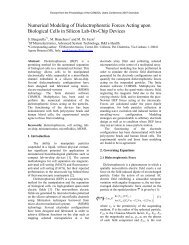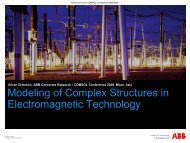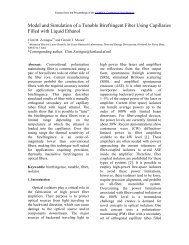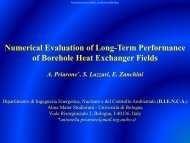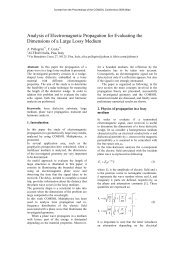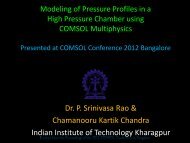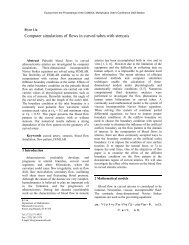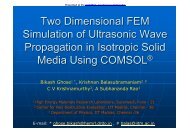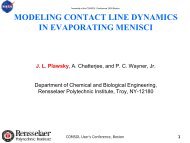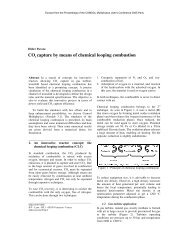3D Simulation of the Thermal Response Test in a U ... - COMSOL.com
3D Simulation of the Thermal Response Test in a U ... - COMSOL.com
3D Simulation of the Thermal Response Test in a U ... - COMSOL.com
You also want an ePaper? Increase the reach of your titles
YUMPU automatically turns print PDFs into web optimized ePapers that Google loves.
Presented at <strong>the</strong> <strong>COMSOL</strong> Conference 2009 Milan
Target<br />
• Commonly used <strong>in</strong> GEOTHERMAL<br />
applications to restore <strong>the</strong> equivalent values<br />
<strong>of</strong> both <strong>the</strong> soil <strong>the</strong>rmal conductivity (λ eq ) and<br />
<strong>the</strong> borehole <strong>the</strong>rmal resistance (Rb eq ).<br />
• The estimation procedure is based on <strong>the</strong><br />
<strong>com</strong>parison <strong>of</strong> experimental TRT data with<br />
<strong>the</strong> solution <strong>of</strong> <strong>the</strong> equations describ<strong>in</strong>g <strong>the</strong><br />
model’s behaviour (i.e. L<strong>in</strong>e Source Model,<br />
Cyl<strong>in</strong>der Source Model).<br />
To discuss <strong>the</strong> capability <strong>of</strong> <strong>the</strong> <strong>Thermal</strong> <strong>Response</strong> <strong>Test</strong> based on <strong>the</strong><br />
L<strong>in</strong>e Source Model with regards to <strong>the</strong> characterization <strong>of</strong> borehole<br />
energy storage systems <strong>in</strong> real conditions <strong>of</strong> non-l<strong>in</strong>ear and nonuniform<br />
heat source.<br />
L<strong>in</strong>da Schiavi – Comsol Conference 2009 2
<strong>3D</strong> transient conduction heat<br />
transfer problem with<strong>in</strong> <strong>the</strong> soil,<br />
<strong>the</strong> borehole fill<strong>in</strong>g material<br />
and <strong>the</strong> HDPE tubes is coupled<br />
with <strong>the</strong> 1D convective<br />
problem with<strong>in</strong> <strong>the</strong> carrier fluid<br />
Geo<strong>the</strong>rmal Energy Storage System’s Geometry<br />
41080 prism mesh<strong>in</strong>g<br />
elements<br />
a) Radial mesh<strong>in</strong>g; b) Axial mesh<strong>in</strong>g<br />
L<strong>in</strong>da Schiavi – Comsol Conference 2009 3
T<br />
T<br />
t<br />
c p<br />
r, z,0<br />
T0<br />
T<br />
r<br />
r<br />
r<br />
t<br />
div<br />
h<br />
o<br />
T<br />
T<br />
fluid<br />
Initial condition<br />
z,<br />
t<br />
T<br />
r , z,<br />
t<br />
t<br />
Boundary condition<br />
Transient tri-dimensional heat transfer<br />
conduction governed by <strong>the</strong> Fourier<br />
equation is solved <strong>in</strong> <strong>the</strong> doma<strong>in</strong> <strong>of</strong> <strong>the</strong><br />
soil, <strong>the</strong> fill<strong>in</strong>g material and <strong>the</strong> HDPE<br />
tubes.<br />
By assum<strong>in</strong>g that <strong>the</strong> convection problem <strong>in</strong> both <strong>the</strong> tubes <strong>of</strong> <strong>the</strong> heat exchanger is<br />
one-dimensional<br />
A<br />
T i<br />
Ti<br />
Ti<br />
f<br />
c<br />
pf<br />
u ho<br />
T rt<br />
, z,<br />
t Ti<br />
z,<br />
t<br />
t z<br />
z, 0 T<br />
0<br />
Initial condition<br />
Energy equation for <strong>the</strong> right-tube<br />
downward fluid flow<br />
A<br />
T f<br />
T<br />
f<br />
T<br />
f<br />
f<br />
c<br />
pf<br />
u ho<br />
T rt<br />
, z,<br />
t T<br />
f<br />
z,<br />
t<br />
t z<br />
z, 0 T<br />
0<br />
Initial condition<br />
Energy equation for <strong>the</strong> left-tube<br />
upward fluid flow<br />
L<strong>in</strong>da Schiavi – Comsol Conference 2009 4
The U-connection at <strong>the</strong> bottom <strong>of</strong> <strong>the</strong> pipe between <strong>the</strong> downward and<br />
upward fluid is here modelled by impos<strong>in</strong>g for z=H that <strong>the</strong> mean<br />
temperature <strong>of</strong> <strong>the</strong> upward fluid equals <strong>the</strong> mean temperature <strong>of</strong> <strong>the</strong><br />
downward fluid:<br />
Ti H , t T<br />
f<br />
H,<br />
t<br />
The condition <strong>of</strong> constant power supplied to <strong>the</strong> work<strong>in</strong>g fluid is implemented<br />
by <strong>the</strong> periodic edge condition:<br />
Ti 0, t Tf<br />
0,<br />
t<br />
T<br />
with T constant over <strong>the</strong> whole temporal doma<strong>in</strong>.<br />
L<strong>in</strong>da Schiavi – Comsol Conference 2009 5
Ma<strong>in</strong> <strong>in</strong>put data for <strong>the</strong> tested cases<br />
Work<strong>in</strong>g Fluid Mass Flowrate<br />
0.1 kg/s<br />
Fluid density 1000 kg/m 3<br />
Fluid specific heat 4186 J/(kg K)<br />
Inlet-Oulet Fluid temperature difference 3.6 K<br />
Convective Coefficient (Dittus-Boelter) 1960 W/(m 2 K)<br />
Soil density 1000 kg/m 3<br />
Soil specific heat 2000 J/(kg K)<br />
CASE A:<br />
Soil <strong>the</strong>rmal conductivity<br />
2 W/(m K)<br />
CASE B:<br />
3 W/(m K)<br />
Fill density 1000 kg/m 3<br />
Fill specific heat 1000 J/(kg K)<br />
Fill <strong>the</strong>rmal conductivity 0.9 W/(m K)<br />
HDPE density 950 kg/m 3<br />
HDPE specific heat 1900 J/(kg K)<br />
HDPE <strong>the</strong>rmal conductivity 0.48 W/(m K)<br />
L<strong>in</strong>da Schiavi – Comsol Conference 2009 6
LINE SOURCE MODEL:<br />
Tf(t) =m+ k*ln(t)<br />
where:<br />
m= T0+ Q/(4 πλH) *(ln(4 α/rb2) -γ) + RbQ/H<br />
k= Q/(4 πλH)<br />
Temporal borehole temperature distribution at z=0<br />
Average fluid temperature versus time for case A<br />
L<strong>in</strong>da Schiavi – Comsol Conference 2009 7
Estimated <strong>the</strong>rmal conductivity for case A<br />
Estimated <strong>the</strong>rmal conductivity for case B<br />
The L<strong>in</strong>e Source Model satisfactory predicts <strong>the</strong> <strong>the</strong>rmal<br />
conductivity <strong>of</strong> <strong>the</strong> soil, by restor<strong>in</strong>g <strong>the</strong> parameter proper<br />
value already <strong>in</strong> <strong>the</strong> first 30 hours.<br />
L<strong>in</strong>da Schiavi – Comsol Conference 2009 8
Estimated borehole <strong>the</strong>rmal resistance<br />
• The two cases differ each o<strong>the</strong>r only for 1,5% for a variation <strong>of</strong><br />
50% <strong>of</strong> <strong>the</strong> soil <strong>the</strong>rmal conductivity.<br />
• They differ from <strong>the</strong> value numerically calculated <strong>in</strong> steady<br />
state regime for less than 5% (R b =0.1625).<br />
L<strong>in</strong>da Schiavi – Comsol Conference 2009 9
• The L<strong>in</strong>e Source Model applied to <strong>the</strong> <strong>Thermal</strong><br />
<strong>Response</strong> <strong>Test</strong> represents a sufficiently<br />
accurate approach also <strong>in</strong> <strong>the</strong> U-tube<br />
configuration.<br />
• The <strong>3D</strong> approach appears necessary when<br />
o<strong>the</strong>r more <strong>com</strong>plex geometric configurations,<br />
or o<strong>the</strong>r phenomena have to be considered.<br />
L<strong>in</strong>da Schiavi – Comsol Conference 2009 10



![[PDF] Microsoft Word - paper.docx - COMSOL.com](https://img.yumpu.com/50367802/1/184x260/pdf-microsoft-word-paperdocx-comsolcom.jpg?quality=85)
